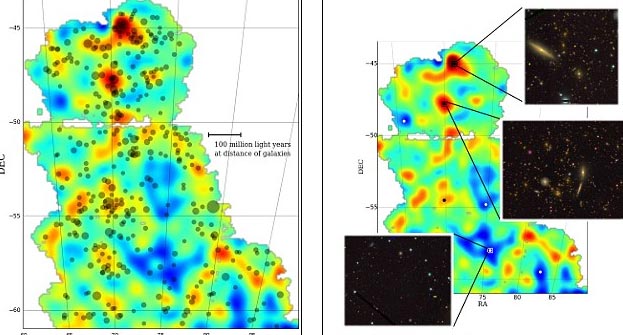Publish the world's first dark matter map
After more than two years of promotion, the team conducted a project on mapping dark matter across the universe, bringing together more than 300 scientists from six countries, published the first valuable data.
First published a map of dark matter
According to experts, dark matter is an invisible "network" that connects galaxies together. By observing how dark matter clusters change over time, scientists hope to finally be able to quantify dark energy - an even more mysterious force, pushing the universe.

The above maps show how dark matter corresponds to how fast galaxies form.The image on the left reveals galaxies adjacent to high density dark matter clusters (red) and lies farther than sparse dark matter areas (blue).The image on the right shows some areas of the sky that have been studied.(Photo: DES)
Of course, we still cannot really observe dark matter directly. Therefore, researchers will have to hunt down their observed effects on galaxies. Researching this effect will help to predict the amount of dark matter in a certain area mapped, based entirely on how they bend light from distant galaxies.
The project, called the Dark Energy Survey (DES ), brings together more than 300 scientists from 6 countries around the world and uses images taken by one of the best digital cameras in the world: a device with a resolution of up to 570 megapixels integrated on Victor Blanco space telescope, at the Inter-American astronomical observatory Cerro Tololo, set high in Chile's Andes.
The DES project started 2 years ago and is expected to be completed in the next 3 years. The goal of DES is to map 3D about 12.5% of the sky . However, the data just released only reflects 0.4% of the universe , but at an unprecedented level of detail. They reveal dark matter structures interspersed with galaxies with gaps in between.
While scientists expand their research, they will be able to better test current cosmological hypotheses, by comparing the amount of dark matter and tangible matter. These hypotheses generally assume that in the universe there are more dark matter than tangible matter and galaxies will form where there is greater concentration of dark matter, meaning stronger gravitational force. .
Eventually, the project results are expected to help experts decipher the mystery of the formation of galaxies.
- New explanation of the origin of dark matter
- 11 mysteries about dark matter have not been answered yet
- Found signs of dark matter
- Revealing the first image of dark matter
- The race to find dark matter is heating up
- Earth is losing dark matter
- The mystery of dark matter has been decoded?
- The first image of the dark matter network, which connects galaxies together
- Detecting dark matter fibers
- Interesting new technology helps explore dark matter
- $ 9.2 million detector looking for dark matter failed
- Decipher the mystery of dark matter
 Van Allen's belt and evidence that the Apollo 11 mission to the Moon was myth
Van Allen's belt and evidence that the Apollo 11 mission to the Moon was myth The levels of civilization in the universe (Kardashev scale)
The levels of civilization in the universe (Kardashev scale) Today Mars, the sun and the Earth are aligned
Today Mars, the sun and the Earth are aligned The Amazon owner announced a secret plan to build a space base for thousands of people
The Amazon owner announced a secret plan to build a space base for thousands of people